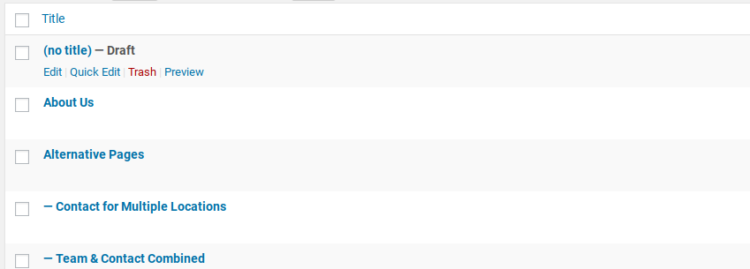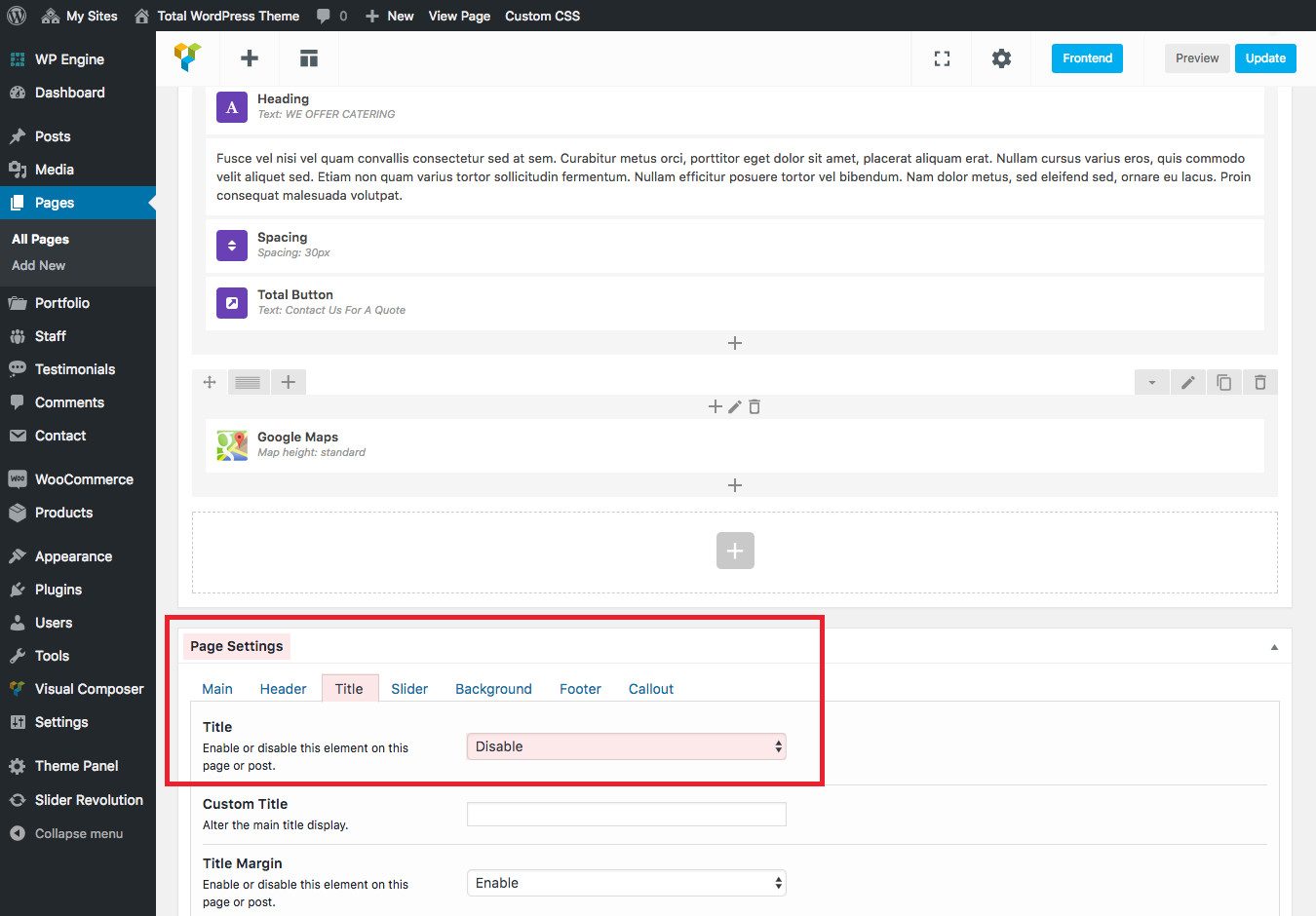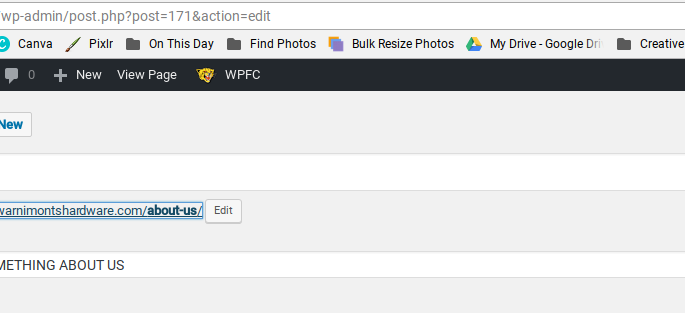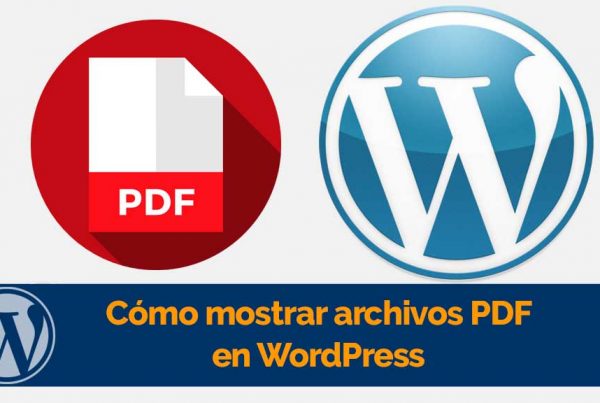Las páginas en WordPress disponen títulos por defecto. Simple como eso.
In some themes, you will notice that titles are occasionally removed from certain pages, but most of the time you have to get your hands dirty and remove them yourself.
Why?
Bueno, a veces un título no pertenece a una página, ya be porque se trata de una distracción o porque no se ve bien en la página. Hay algunos trucos de diseño para reemplazar o enmascarar el título de la página, pero la mayoría de ellos requieren algunas conjeturas y verificación, y otros son más como curitas para una solución que debería ocultar el título por completo.
The target aquí es minimizar cualquier cosa que pueda parecer fuera de lugar o desconcertante para el Username. Su user interface es evidentemente importante. Para algunas páginas, esto es concretamente cierto. Tome las páginas de destino y las páginas estáticas utilizadas para las páginas de inicio.
If you're still wondering what is the main reason for hiding page titles in WordPress, keep reading below.
Why would you want to hide page titles in WordPress?
At first, you may wonder precisely why hiding a page title has any advantage. But I guess you've ever come across a page that doesn't require a page title for aesthetic reasons or because it's going to hurt your business in general.
What are some of the reasons you might be able to hide your page title?
1. You are using a normal WordPress page as your home page.
Esto ocurre con bastante frecuencia cuando no está interesado en tener un feed de Blog regular en la página de inicio. Muchos sitios Web crean una página de inicio con botones, medios y otros items específicos en un esfuerzo por hacer que la página de inicio predeterminada de WordPress se parezca más a un portal web normal. A veces, el tema que elijas ya elimina el título de la página. En otras ocasiones, es factible que tenga que ir allí y completar la tarea manualmente.
The procedure of making a normal home page as your home page is usually referred to as a "static" page, where you simply remove the "Home" or "Home page" title that no one needs to see in the first place.
2. You create a page and find that the title seems out of place.
En ocasiones, puede generar una página que no requiere un título de página en absoluto. He visto que esto ocurre al insertar cosas como foros o galerías en una página. Inclusive algunas páginas de Contáctenos se ven un poco tontas con títulos grandes y desagradables en la parte de arriba. He notado que esto sucede usualmente cuando estás centrando el contents y el título permanece en el lado izquierdo. O a veces el título es repetitivo o los usuarios ya conocen dónde están terminando luego de hacer un clic en el elemento del menú.
3. Le gustaría crear una página de destino.
La página de destino es una de las principales razones por las que querrías deshacerte de ese molesto título de página. Las páginas de destino están destinadas a fomentar sus conversiones, y un título usualmente distrae al usuario de áreas como su formulario de registro de email o un botón Comprar. Posteriormente de todo, generalmente no hay razón para decirle a la gente dónde aterrizaron con un título cuando probablemente hayan hecho clic en un anuncio de Google or Facebook. Sería mejor empezar la página con un video y omitir el título de la página por completo.
Let's do it: How to hide page titles in WordPress
After completing a Google search to hide page titles, you may come across some posts that talk about installing a plug-in for this purpose. Unfortunately, this plugin is no longer enabled, so we will have to complete a manual method.
That's not necessarily a bad thing either, given that deleting a title is pretty basic, making it questionable to use a plugin that might not update in the first place. Including a bit of code may seem intimidating to some, but it's actually pretty straightforward. And it's less likely to open security vulnerabilities or slow down your site (which could happen with a plugin).
Warning: this is how NOT to hide page titles
It is common for WordPress users to open a page and leave the title field blank. We highly recommend against this For two reasons.
First of all, you will have a hard time finding these pages in the future, as WordPress displays "untitled" text in its page list. This is not a way to organize your pages, especially if you plan to have multiple "untitled" pages.

En segundo lugar, WordPress genera su propio link permanente cuando el campo de título se deja vacío. De esta manera, tendrá que recordar editar el link permanente manualmente. Caso contrario, su SEO se verá afectado, dado que puede conseguir un link permanente aleatorio con un montón de números o palabras que no significan nada.
Not only that, but pages in WordPress won't publish if you don't have a title marked there. Posts, on the other hand, are made public without a title. This way, if you still decide to stick with this method (which is not a good idea), you should publish the page with a title, then come back to delete the title and publish it again. Again, it would be a bit silly to even consider this, thus this is more of a reminder of the downfalls of the method.
The best ways to hide page titles in WordPress
You have two options here: use a WordPress theme that includes a built-in option to hide titles, or add a bit of code to a child theme to make the change yourself.
1. Use a WordPress theme to hide titles
Your easiest option is basically to use a theme that already includes the option to hide titles on posts or pages. A great example is the Total WordPress theme. Since the drag and drop theme is designed to work for a variety of purposes, there are special functions built in to make the theme more flexible. This includes tons of advanced options for image cropping, site width, and what is displayed at the top of the pages.

To hide the title of a page in Total, basically create your new page (or open a page that you have already created with the drag and drop page builder, like one of these common website building tools Using the Website Builder Insider Information), scroll down to "Page Settings", click on the "Title" tab and then select the option to "Disable" the publishing page / tile. Save your changes when you are done.
Con el título de la página deshabilitado, puede crear su propio diseño personalizado. Solo recuerde volver a agregar títulos a su página a medida que crea un nuevo diseño usando los títulos adecuados H1, H2, H3, etc.

Por ejemplo, esta página en particular en el Demostración total del tema se creó usando los módulos Total personalizados para Visual Composer. Sin un encabezado estándar o un título de página que se interponga en el camino, esta página de destino estilo restaurante agrega un título personalizado con un botón de llamada (mucho mejor para captar la atención del client).
But if you are not willing to change the subject, you can delete your page titles manually using a child theme.
2. Add code to a WordPress child theme to hide titles
You have the option to insert some conditions for the title tags in your theme files. But that sounds complicated and we are not trying to complicate it.
De esta manera, debe optar por ocultar títulos de página específicos en la style sheet CSS.
Create a child topic (IMPORTANT)
To get started, you will first need to create a WordPress child theme. This step is crucial to ensure that the edits you make to your stylesheet are maintained as you update your main WordPress theme in the future.
Esto requerirá que tenga acceso SFTP a su sitio de WordPress, y le sugerimos que no utilice este método si no está familiarizado con CSS, PHP o con su server para ingresar a archivos.
But it will simply create a new Theme-Child folder under wp-content / themes, add a style.css file to your new Theme-Child folder and then queue your original theme style by adding a functions.php file with some code in your Theme-Child folder (you can see this procedure in detail with screenshots in our guide on how to create a landing page with WordPress).
With your child's theme ready to go, you can move on to the next step.
Determine the title class of your page
Go to the interface of the page you want to edit and right click on it. Select the Watch source code option (sometimes displayed as View source or Page source). You can also click on To inspect for a smoother viewing experience.
This should show a lot of code. We are trying to find the name of the "class" that accompanies its title tag. Search for your page name using the Search shortcut (Ctrl + F / Command + F)
For example, the title of my page is "Contact Us." When using the Search shortcut, you highlight all instances of the Contact Us text. You will probably have to hit Enter several times to locate the instance that interests us.
It looks like the screenshot below, where the title appears after the "h1class =" tag.

The class is right after
Once you have the class for your title tag, copy it to use later.
Find the page ID
Hallar el ID de la página es un poco más fácil. En su panel de WordPress. Abra el editor de la página para la que está intentando conseguir el ID de página. Mire la Url de esa página en su browser. Su ID de página es el número luego de «artículo =». Entonces para mí sería 171.

Please mark your Page ID.
Put code in the stylesheet
Now open the new style.css file you created for your Theme-Child folder and paste the following code:
/ * Hide title on About Us page * / .page-id-171 .main-title__primary {display: none; }
The only difference for you is that you will insert your own page name in the notation, page ID and class.
After saving the stylesheet, you should be able to go to that page's interface and see the hidden page title. If it doesn't work at first, try republishing the page.
That's it!
There you have it: a couple of easy ways to erase the title of your WordPress pages. If you have any questions about hiding page titles in WordPress, or additional suggestions that you think other readers might find helpful, please let us know in the comments below.






